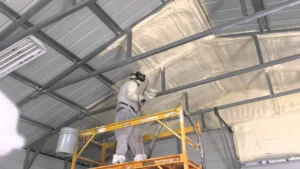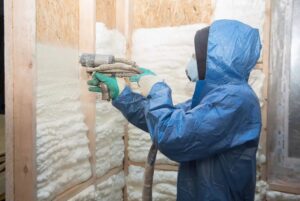Spray foam insulation has become a popular choice for various types of buildings, including pole barns. When evaluating whether spray foam insulation for a pole barn is worth the investment, the answer is dependent on several factors, including climate, intended use, budget, and the long-term benefits it offers. This article will explore these factors in detail, providing a comprehensive analysis to help you make an informed decision.
Advantages of Spray Foam Insulation for Pole Barns
Spray foam insulation is a high-performance option for insulating pole barns, offering several advantages over traditional insulation methods. Here are the key reasons why it may be worth considering:
- Superior Insulation Performance: Spray foam provides high R-values per inch, offering excellent thermal resistance, which helps maintain a consistent temperature inside the barn.
- Air and Moisture Barrier: It expands upon application, filling gaps and cracks, which prevents air leaks and moisture buildup—two common issues with pole barns.
- Long-Term Durability: Spray foam does not settle over time like fiberglass insulation, maintaining its performance for the long haul.
- Energy Efficiency: By reducing air leaks and providing superior thermal insulation, spray foam can lower energy costs, particularly in climates with extreme temperatures.
Disadvantages of Spray Foam Insulation for Pole Barns
While spray foam insulation offers many benefits, it also comes with some potential drawbacks that need to be considered before making an investment:
- Higher Initial Cost: The installation cost of spray foam insulation is typically higher than traditional insulation methods, such as fiberglass or cellulose.
- Professional Installation Required: Spray foam must be applied by trained professionals to ensure proper installation and avoid issues like improper expansion or uneven coverage.
- Potential for Over-Insulation: In certain climate zones, excessive insulation can lead to issues with moisture and ventilation, making it important to balance insulation levels with the specific needs of your pole barn.
Types of Spray Foam Insulation for Pole Barns
There are two primary types of spray foam insulation that can be used in pole barns:
Open-Cell Spray Foam
- Characteristics: Lighter and less dense, open-cell foam is more flexible and absorbs moisture.
- R-Value: Typically around 3.5 to 4 per inch.
- Best Use: Ideal for moderate climates where moisture buildup is less of a concern.
Closed-Cell Spray Foam
- Characteristics: Denser and more rigid, closed-cell foam acts as a vapor barrier, preventing moisture infiltration.
- R-Value: Typically around 6 to 7 per inch.
- Best Use: Ideal for extreme climates and areas where moisture control is critical, such as in regions with high humidity.
Comparison Table: Open-Cell vs. Closed-Cell Spray Foam
| Feature | Open-Cell Spray Foam | Closed-Cell Spray Foam |
| R-Value per Inch | 3.5–4 | 6–7 |
| Moisture Resistance | Low | High |
| Flexibility | High | Low |
| Density | Low | High |
| Cost | Lower | Higher |
| Best Use | Moderate Climates | Extreme Climates |
Things to Consider Before Making a Decision
Before deciding on spray foam insulation for your pole barn, there are several important factors to consider:
Climate and Temperature Control
The local climate plays a major role in determining whether spray foam insulation is worth the investment. If you live in an area with extreme temperatures or high humidity, closed-cell foam may be more beneficial due to its higher R-value and moisture resistance. In contrast, open-cell foam may suffice for milder climates where insulation needs are less stringent.
Intended Use of the Pole Barn
Consider how the pole barn will be used. For example, if the barn will house livestock, store temperature-sensitive equipment, or serve as a workshop, maintaining a stable internal temperature will be crucial. Spray foam insulation can help achieve this by providing superior thermal resistance and air sealing.
Budget and Long-Term Savings
While spray foam insulation has a higher upfront cost than traditional insulation, it can offer substantial long-term savings by improving energy efficiency. Reduced heating and cooling costs over time can offset the initial investment. It’s important to calculate these potential savings based on your energy usage and local energy prices.
Installation Time and Expertise
Spray foam insulation should be applied by professionals with the proper training and equipment. The installation process can take several days, depending on the size of the pole barn and the complexity of the job. Ensure that you work with a reputable contractor who specializes in spray foam insulation to avoid issues like uneven application or health hazards related to improper installation.
Ventilation and Moisture Management
Spray foam’s ability to seal gaps and cracks also means that proper ventilation must be ensured in the pole barn. Without adequate airflow, trapped moisture can lead to mold growth, which can damage the structure over time. Consider integrating a proper ventilation system alongside insulation installation to prevent these issues.
Common Questions About Spray Foam Insulation for Pole Barns
1. Is spray foam insulation effective for pole barns in all climates?
Yes, but the type of foam used should be matched to the climate. Closed-cell foam is ideal for extreme climates and moisture-prone areas, while open-cell foam is better for milder conditions.
2. Can spray foam insulation be installed in an existing pole barn?
Yes, spray foam can be applied to existing pole barns. However, it’s important to evaluate whether the barn is structurally sound and if any moisture problems need to be addressed before installation.
3. How does spray foam compare to fiberglass insulation in terms of cost?
Spray foam insulation typically costs more than fiberglass insulation, but the long-term savings in energy efficiency can make it a worthwhile investment.
4. Is spray foam insulation a permanent solution?
Yes, spray foam insulation is durable and can last the lifetime of the building, provided it is installed correctly and there is no excessive moisture buildup.
Technical Specs for Spray Foam Insulation
| Property | Open-Cell Spray Foam | Closed-Cell Spray Foam |
| R-Value per Inch | 3.5–4 | 6–7 |
| Density (lbs/ft³) | 0.5–1 | 2–3 |
| Water Vapor Permeability | High (not moisture-resistant) | Low (moisture-resistant) |
| Compression Strength | Low | High |
| Sound Dampening | High | Low |
| Life Expectancy | 20–30 years | 30+ years |
Make the Right Decision
Spray foam insulation offers excellent benefits for pole barns, including superior insulation performance, moisture resistance, and energy efficiency. However, its higher initial cost and the need for professional installation are important considerations. Evaluate your local climate, barn usage, and budget before deciding if spray foam insulation is the right choice for your pole barn.
FAQ Section
1. How much does spray foam insulation cost for a pole barn?
The cost varies depending on the size of the barn, the type of foam used, and the installation labor. On average, expect to pay between $1.50 to $3.50 per square foot for spray foam installation.
2. Will spray foam insulation prevent all moisture problems?
Closed-cell spray foam can effectively prevent moisture from entering, but open-cell foam may still allow moisture to penetrate. Ensuring proper ventilation is key to managing moisture in the barn.
3. Can I install spray foam insulation myself?
It is not recommended to install spray foam insulation yourself. Professional installation ensures proper application and safety, and the foam must be installed under controlled conditions to prevent health risks.
4. Does spray foam insulation increase property value?
Yes, spray foam insulation can increase the energy efficiency of your pole barn, which may enhance its resale value, especially if you live in an area with extreme weather conditions.

